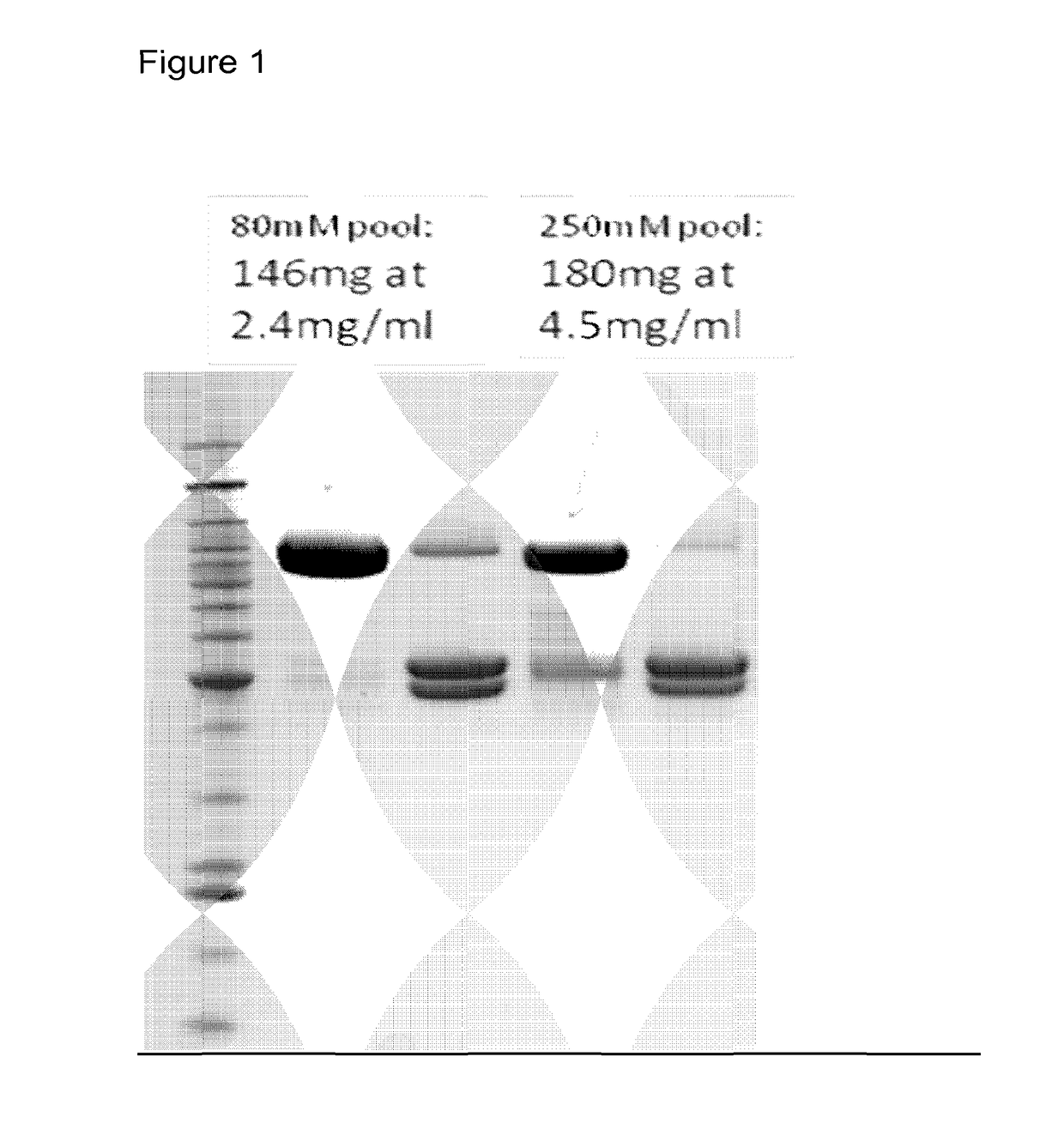Therapeutic fusion proteins
a technology of fusion proteins and fusion proteins, which is applied in the direction of drug compositions, peptide/protein ingredients, enzyme stabilisation, etc., can solve the problems of mixed population of modified toxin molecules, difficult control of chemical conjugation, and inconvenient us
- Summary
- Abstract
- Description
- Claims
- Application Information
AI Technical Summary
Benefits of technology
Problems solved by technology
Method used
Image
Examples
example 1
Creation of an LHD Protein that Incorporates a GnRH Polypeptide to the C-Terminus of the HN Domain
[0369]The primary sequence of a chimaeric protein constructed by a genetic fusion of the LHN fragment of BoNT / D and the 10 amino acid peptide GnRH is reviewed for the presence of amino acid strings that bear resemblance to the prototypical recognition site for Factor Xa (IEGR) (SEQ ID NO: 33). As no such string is found, the choice is made to use FXa as the protease to both activate the fusion protein at the LC-HN junction and also to cleave the peptide bond between the HN and the TM (GnRH).
[0370]DNA optimised for E. coli expression is obtained commercially from Entelechon (Germany) to encode a fusion protein which has the following structure, from N- to C-terminus:[0371]10 His N-terminal purification tag (SEQ ID NO: 48),[0372]a 10 asparagine amino acid spacer (SEQ ID NO: 49),[0373]the LC of BoNT / D,[0374]an inter-domain linker with a primary sequence similar to the found in BoNT / A, modi...
example 2
Creation of an LHA Protein that Incorporates a GnRH Polypeptide to the C-Terminus of the HN Domain
[0379]The primary sequence of a chimaeric protein constructed by a genetic fusion of the LHN fragment of BoNT / A and the 10 amino acid peptide GnRH is reviewed for the presence of amino acid strings that bear resemblance to the prototypical recognition site for Factor Xa (IEGR) (SEQ ID NO: 33). As no such string is found, the choice is made to use FXa as the protease to both activate the fusion protein at the LC-HN junction and also to cleave the peptide bond between the HN and the TM (GnRH).
[0380]DNA optimised for E. coli expression is obtained commercially from Entelechon (Germany) to encode a fusion protein which has the following structure, from N- to C-terminus:[0381]10 His N-terminal purification tag (SEQ ID NO: 48),[0382]a 10 asparagine amino acid spacer (SEQ ID NO: 49),[0383]the LC of BoNT / A,[0384]an inter-domain linker with a primary sequence similar to the found in BoNT / A, modi...
example 3
Creation of an LHD Protein that Incorporates a GnRH Polypeptide to the C-Terminus of the HN Domain, where Two Different Protease Recognition Sites are Incorporated
[0389]The primary sequence of a chimaeric protein constructed by a genetic fusion of the LHN fragment of BoNT / D and the 10 amino acid peptide GnRH is reviewed for the presence of amino acid strings that bear resemblance to the prototypical recognition site for Factor Xa (IEGR) (SEQ ID NO: 33) and enterokinase (DDDDK) (SEQ ID NO: 32). As no such string is found, the choice is made to use FXa as the protease to activate the fusion protein at the LC-HN junction and enterokinase to cleave the peptide bond between the HN and the TM (GnRH).
[0390]DNA optimised for E. coli expression is obtained commercially from Entelechon (Germany) to encode a fusion protein which has the following structure, from N- to C-terminus:[0391]10 His N-terminal purification tag (SEQ ID NO: 48),[0392]a 10 amino acid asparagine spacer (SEQ ID NO: 49),[03...
PUM
| Property | Measurement | Unit |
|---|---|---|
| covalent linkage | aaaaa | aaaaa |
| secondary polypeptide structure | aaaaa | aaaaa |
| nucleic acid | aaaaa | aaaaa |
Abstract
Description
Claims
Application Information
 Login to View More
Login to View More - R&D
- Intellectual Property
- Life Sciences
- Materials
- Tech Scout
- Unparalleled Data Quality
- Higher Quality Content
- 60% Fewer Hallucinations
Browse by: Latest US Patents, China's latest patents, Technical Efficacy Thesaurus, Application Domain, Technology Topic, Popular Technical Reports.
© 2025 PatSnap. All rights reserved.Legal|Privacy policy|Modern Slavery Act Transparency Statement|Sitemap|About US| Contact US: help@patsnap.com



